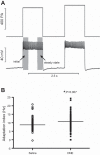Influence of developmental nicotine exposure on spike-timing precision and reliability in hypoglossal motoneurons
- PMID: 25552642
- PMCID: PMC4359999
- DOI: 10.1152/jn.00838.2014
Influence of developmental nicotine exposure on spike-timing precision and reliability in hypoglossal motoneurons
Abstract
Smoothly graded muscle contractions depend in part on the precision and reliability of motoneuron action potential generation. Whether or not a motoneuron generates spikes precisely and reliably depends on both its intrinsic membrane properties and the nature of the synaptic input that it receives. Factors that perturb neuronal intrinsic properties and/or synaptic drive may compromise the temporal precision and the reliability of action potential generation. We have previously shown that developmental nicotine exposure (DNE) alters intrinsic properties and synaptic transmission in hypoglossal motoneurons (XIIMNs). Here we show that the effects of DNE also include alterations in spike-timing precision and reliability, and spike-frequency adaptation, in response to sinusoidal current injection. Current-clamp experiments in brainstem slices from neonatal rats show that DNE lowers the threshold for spike generation but increases the variability of spike-timing mechanisms. DNE is also associated with an increase in spike-frequency adaptation and reductions in both peak and steady-state firing rate in response to brief, square wave current injections. Taken together, our data indicate that DNE causes significant alterations in the input-output efficiency of XIIMNs. These alterations may play a role in the increased frequency of obstructive apneas and altered suckling strength and coordination observed in nicotine-exposed neonatal humans.
Keywords: development; intrinsic properties; motoneuron; nicotine; spike-timing precision; spike-timing reliability.
Copyright © 2015 the American Physiological Society.
Figures









Similar articles
-
Developmental nicotine exposure alters glycinergic neurotransmission to hypoglossal motoneurons in neonatal rats.J Neurophysiol. 2018 Sep 1;120(3):1135-1142. doi: 10.1152/jn.00600.2017. Epub 2018 May 30. J Neurophysiol. 2018. PMID: 29847237 Free PMC article.
-
Developmental nicotine exposure alters potassium currents in hypoglossal motoneurons of neonatal rat.J Neurophysiol. 2017 Apr 1;117(4):1544-1552. doi: 10.1152/jn.00774.2016. Epub 2017 Feb 1. J Neurophysiol. 2017. PMID: 28148643 Free PMC article.
-
Developmental nicotine exposure alters neurotransmission and excitability in hypoglossal motoneurons.J Neurophysiol. 2011 Jan;105(1):423-33. doi: 10.1152/jn.00876.2010. Epub 2010 Nov 10. J Neurophysiol. 2011. PMID: 21068261 Free PMC article.
-
Changes during the postnatal development in physiological and anatomical characteristics of rat motoneurons studied in vitro.Brain Res Brain Res Rev. 2005 Sep;49(2):377-87. doi: 10.1016/j.brainresrev.2005.02.003. Epub 2005 Mar 24. Brain Res Brain Res Rev. 2005. PMID: 16111564 Review.
-
Determinants of respiratory motoneuron output.Respir Physiol. 2000 Sep;122(2-3):259-69. doi: 10.1016/s0034-5687(00)00164-x. Respir Physiol. 2000. PMID: 10967349 Review.
Cited by
-
Hemizygous Deletion on Chromosome 3p26.1 Is Associated with Heavy Smoking among African American Subjects in the COPDGene Study.PLoS One. 2016 Oct 6;11(10):e0164134. doi: 10.1371/journal.pone.0164134. eCollection 2016. PLoS One. 2016. PMID: 27711239 Free PMC article.
-
Developmental nicotine exposure alters glycinergic neurotransmission to hypoglossal motoneurons in neonatal rats.J Neurophysiol. 2018 Sep 1;120(3):1135-1142. doi: 10.1152/jn.00600.2017. Epub 2018 May 30. J Neurophysiol. 2018. PMID: 29847237 Free PMC article.
-
Influence of developmental nicotine exposure on the ventilatory and metabolic response to hyperthermia.J Physiol. 2015 Dec 1;593(23):5201-13. doi: 10.1113/JP271374. J Physiol. 2015. PMID: 26427762 Free PMC article.
-
Central nervous system integration of sensorimotor signals in oral and pharyngeal structures: oropharyngeal kinematics response to recurrent laryngeal nerve lesion.J Appl Physiol (1985). 2016 Mar 1;120(5):495-502. doi: 10.1152/japplphysiol.00946.2015. Epub 2015 Dec 17. J Appl Physiol (1985). 2016. PMID: 26679618 Free PMC article.
-
Dual recombinase fate mapping reveals a transient cholinergic phenotype in multiple populations of developing glutamatergic neurons.J Comp Neurol. 2020 Feb 1;528(2):283-307. doi: 10.1002/cne.24753. Epub 2019 Aug 22. J Comp Neurol. 2020. PMID: 31396962 Free PMC article.
References
-
- Beierholm U, Nielsen CD, Ryge J, Alstrom P, Kiehn O. Characterization of reliability of spike timing in spinal interneurons during oscillating inputs. J Neurophysiol 86: 1858–1868, 2001. - PubMed
-
- Berlin I, Heilbronner C, Georgieu S, Meier C, Spreux-Varoquaux O. Newborns' cord blood plasma cotinine concentrations are similar to that of their delivering smoking mothers. Drug Alcohol Depend 107: 250–252, 2010. - PubMed
-
- Binder MD, Heckman CJ, Powers RK. The physiological control of motoneuron activity. In: Handbook of Physiology. Exercise: Regulation and Integration of Multiple Systems. Bethesda, MD: Am Physiol Soc, 1996, sect. 12, 1996, p. 3–53
-
- Brody CD, Hopfield JJ. Simple networks for spike-timing-based computation, with application to olfactory processing. Neuron 37: 843–852, 2003. - PubMed
-
- Brunel N, Chance FS, Fourcaud N, Abbott LF. Effects of synaptic noise and filtering on the frequency response of spiking neurons. Phys Rev Lett 86: 2186–2189, 2001. - PubMed
Publication types
MeSH terms
Substances
Grants and funding
LinkOut - more resources
Full Text Sources
Other Literature Sources

